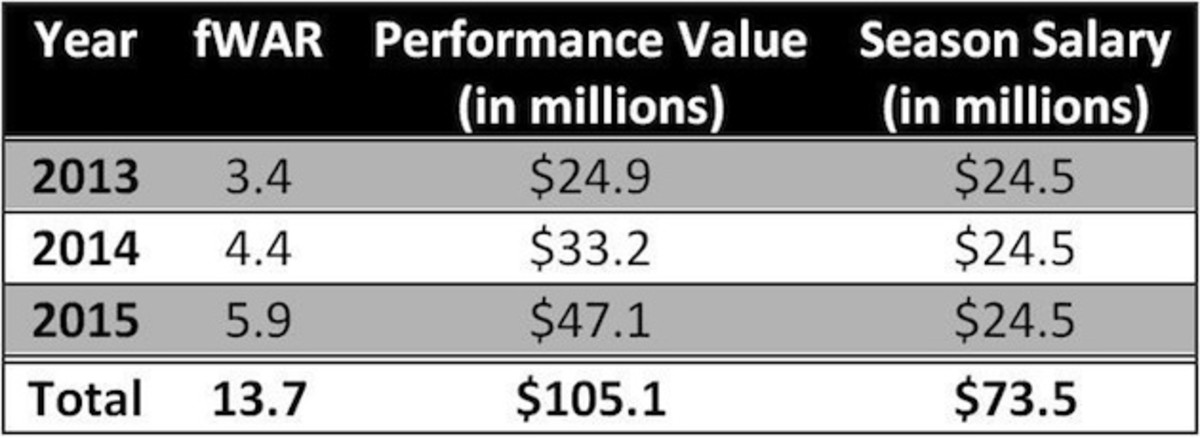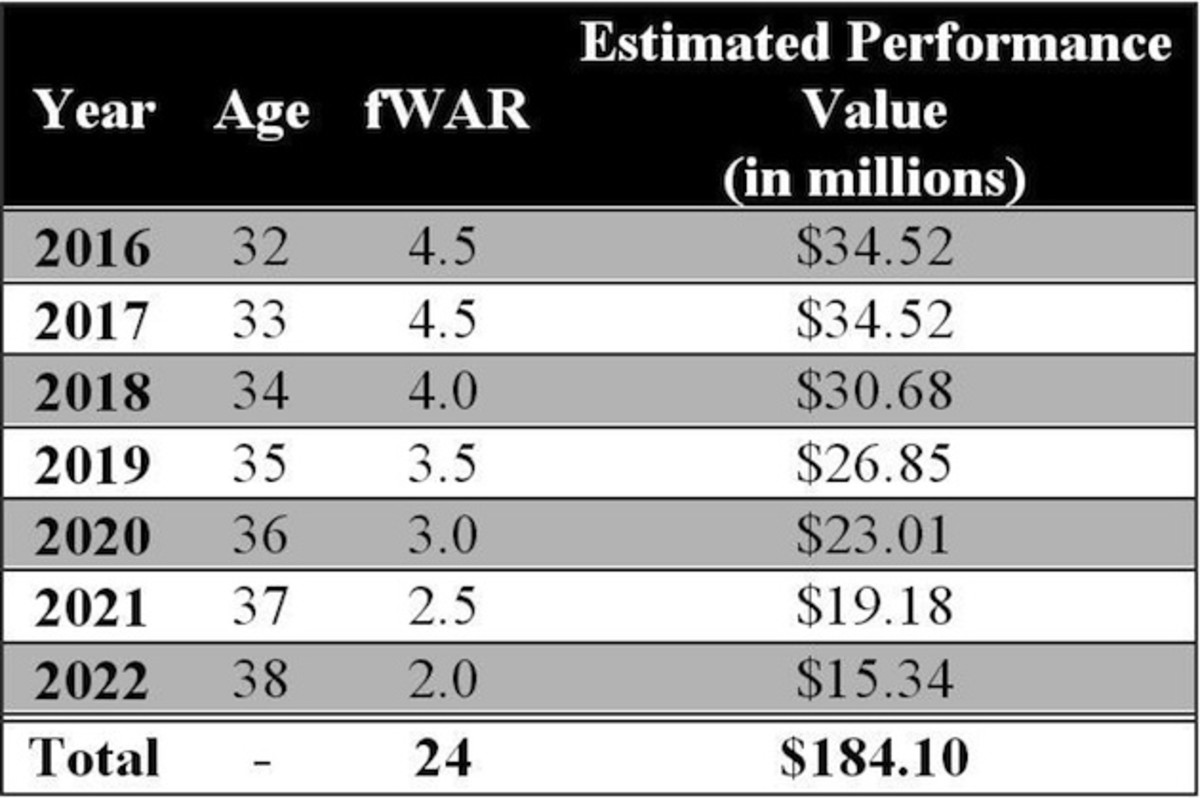Determining Zack Greinke's free-agency market value

On Wednesday, reports surfaced that Los Angeles Dodgers ace Zack Greinke — on the heels of a meteoric season in which the crafty righty registered a 19–3 record with a 1.66 ERA and 0.86 WHIP — will opt out of the final three years and $71 million left on his current contract and become a free agent.
The decision, while potentially landscape-shifting, came as no surprise. The Dodgers, after all, had agreed to the opt-out clause after signing the 32-year-old to a six-year, $147 million contract during the 2013 offseason.
As Bill Shaikin of the Los Angeles Times pointed out, Greinke’s free agency was foreshadowed as early as the 2014 All-Star Game, when the Dodgers hurler hinted he was waiting to see how Max Scherzer and Jon Lester fared in their free-agency bids. Needless to say, those two wound up doing pretty well for themselves. Now it’s Greinke’s turn to dive headfirst into the free-agent market in an attempt to enter the $200 Million Pitcher Club with his own long-term deal.
Will the Dodgers be strong bidders for Greinke? More crucially, does Greinke’s body of work support what will undoubtedly be a hefty investment?
On the field, Greinke has been everything L.A. could’ve hoped for over the last three seasons, a stretch that has seen the Dodgers win three straight NL West crowns. Pairing him alongside Cy Young Award winner Clayton Kershaw, Los Angeles boasted arguably the best one-two combination in the Majors.
Greinke’s performance and consistency have been unquestioned. And as he continues to enjoy career prime, any team that signs him is bound to reap immediate benefits. Rather, what the Dodgers need to spend a long time analyzing — ditto any other team who gets involved in the bidding — is how the resulting deal might affect the club as the contract begins to wind down. That means looking at Greinke’s body of work and comparing it with other, similarly successful pitchers recently signed to lucrative long-term deals.
Greinke established a 51–15 record in his three seasons with the Dodgers, compiling a 2.30 ERA (2.97 FIP) with 8.3 K/9 and 1.9 BB/9 ratios in just over 600 innings (per FanGraphs). Moreover, Greinke’s combined 13.7 fWAR ranks eighth among all qualified Major League starting pitchers over the last three seasons.
Among starting pitchers with fWAR measures better than Greinke’s during the span, four of them have recently signed lucrative contracts: Felix Hernandez (seven years, $175 million in 2013), Kershaw (seven years, $215 million in 2014), Jon Lester (six years, $155 million in 2015), and Max Scherzer (seven years, $210 million in 2015).
With the exception of Kershaw, the ages of the above-mentioned players are all similar; it's the number of innings on those arms that differ wildly.

Not only is Greinke the oldest among the group (a full two months and change older than Lester); he’s also logged the second-most innings. While Greinke is not an especially hard thrower, durability might become an issue as he ages — as it does for any starting pitcher. And While Greinke’s combined fWAR since 2013 is the lowest in the group, he’s also seen that number rise in each season since his inaugural Dodgers campaign, ranking third among the five pitchers this season (5.9).
Greinke will no doubt press for a contract near the $200 million mark —or at least one which pays him close to $30 million annually . But is he worth that kind of coin? Beyond comparing the stats, Greinke’s suitors must try and determine how his past performance will measure up to his expected-performance value.
Baseball clubs have been known to make some ambitious assumptions on long-term contracts, and Greinke’s will likely be no different. A player in his early 30s (check), coming off an impressive season (check), boasting a track record of above-average production (check) — these tend to make for big contracts, where teams talk themselves into eating the risk at the back end of the deal for what they feel is a safe bet up front.
FanGraphs calculates a handy performance value for each player based on the WAR formula. Basically, it tells us what the player was worth for the season had he been a free agent. Below we see Greinke’s performance value as compared with his salary over the last three seasons with the Dodgers.

In short, Greinke’s value to the Dodgers far outweighed the actual salary paid him. As such, we can use the values above to approximate Greinke’s future performance value per 1.0 fWAR at $7.67 million.
When we average out Greinke’s fWAR from those same seasons, we get a number of 4.56. In order to make the numbers simpler to follow, we’ll round down to 4.5.
After assuming Greinke will be able to pitch at the same level in his age-33 and age-34 seasons (at 4.5 fWAR), we can likely expect his performance to tail off over the balance of his contract. For this demonstration, I’m using decreases of 0.5 fWAR — a reasonable assumption, all things considered.

Based on a) Greinke’s current age, and b) the contracts that preceded his, it's hard to believe anyone will offer him a contract longer than six years. Using the above evaluation, Greinke would yield a performance value of $30.86 million per season, on average. As such, a deal of six-years, $184 million is right about where I'd expect Greinke’s agent to begin negotiations.
Bear in mind, of course, that his suitors — the Dodgers included — will want to maximize the difference between Greinke’s actual salary and what they perceive to be his future performance value. Because of this, teams might seek to build in a $3–4 million cushion for each season in order to offset potential production issues (or worse, significant injury).
Remember, baseball is, above all, a business; teams will always look to net extra worth over the course of the deal. That could put Greinke’s best offers somewhere in the six-year, $160–166 million mark, or $26.67-$27.87 million annually.
That lower end, it should be noted, is very much in line with what Lester and the Chicago Cubs settled on last offseason. Based on these values, Greinke could very well be in line for a modest annual raise. More importantly, he’d net three more years of guaranteed salary as he enters his twilight years.
When all is said and done, the Dodgers offer (considering the team's deep, deep pockets) is likely to end up atop the bidding heap. For L.A., having Greinke and Kershaw (who has an opt-out in his contract after the 2018 season) at the front of the rotation for the next several seasons not only keeps the Hollywood fans happy and engaged; it gives the club a very real advantage — statistical as well as psychological — over most teams.
The familiarity with the Dodgers may also play a part in Greinke’s decision-making process (he suffered from anxiety disorder earlier in his career), as will the franchise’s continued commitment to field a competitive team.
Ultimately, Greinke is poised to cash in big — and likely without having to hire movers.
(Contributed to The Cauldron by Chris Carelli.)

